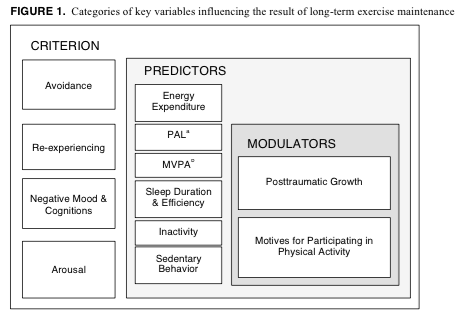About This Project
Regular physical activity remains an unequivocal form of preventative and rehabilitative treatment that greatly reduces the development of risks tied to metabolic syndrome, heart disease, and cognitive decline. Those who suffer from PTSD are characterized as having poor health status and do not participate in sufficient levels of PA. Participants will be affixed with a Sensewear Armband for a period of 7-10 days to classify distinct characteristics and patterns of activity among combat Veterans. Findings may provide new or improved direction for specific exercise prescription or treatment-based interventions for those with PTSD.
Ask the Scientists
Join The DiscussionWhat is the context of this research?
Emerging evidence suggests that chronic psychological distress can influence an individual's likelihood of participating in physical activity (Martins et al., 2013, Bertheussen et al., 2011, Hall et al., 2014, Rosenbaum et al. 2014). Veterans with PTSD are at higher risk of suffering from cardiovascular and metabolic diseases. They also demonstrate negative associations with vigorous exercise and physical performance. Veteran's returning from combat operations (OEF, OIF) self-report wait times, travel distances to care-facilities, and concerns of stigmatization as significant barriers to local health care access. Exercise is medicine and often times it becomes the ideal treatment for age-related decline, chronic illness and psychological distress, such as PTSD.
What is the significance of this project?
The prevalence of mental illness in the United States continues to increase with each passing year and nearly 25 percent of all U.S. adults are living with a mental illness. About 50 percent of the entire population will develop at least one mental illness during their lifespan (CDC 2014; Colpe, Freeman, & Strine, 2010). Data collected from this study may offer predictive value toward determinants of long-term exercise maintenance or other specific health behaviors for who have mental health concerns nationwide.
What are the goals of the project?
The primary goal of this study is to identify factors that promote habitual exercise among Veterans with PTSD. Additionally, obtaining objective data concurrent to symptom severity among this high interest population is of critical interest and will be used to justify exercise-based interventions to improve quality of life in those diagnosed with PTSD. Lastly, this study also aims to develop and log reproducible practices for objectively assessing physical activity among our participants for similar studies in the future.
Budget
Up to 15 SenseWear Armbands will be purchased to examine objective measures of activity in combat Veterans. The SenseWear Armband is a multi-sensor activity monitor that is worn on the upper arm over the triceps muscle. It combines heat-related sensor data with tri-axial accelerometry to assess energy expenditure and physical activity levels using complex pattern-recognition algorithms. This device has been validated for research.
***All armbands will be donated to the University of South Carolina Exercise Science Department for similar studies by future students***
Achievement-based Incentive Pay will be provided to all participants who return all components of their armband upon their second visit, fully functional and undamaged; 10 dollars of 4 or less valid days of data and 20 dollars for greater than 4 days of valid data. Those who complete the exit questionnaire will also be awarded an embroidered Move More patch commensurate of uniform badges denoting service.
Meet the Team
Team Bio
Danny is currently a Master student at the University of South Carolina studying Exercise Science with an emphasis on Rehabilitation Science.
Danny has always been interested in empowering individuals to take charge of their own physical and mental well-being with a holistic approach. Physical activity is a crucial component of healthy living but it is our brain that can do so much for us as we try to decrease the prevalence of chronic illness and maintain and improve mental health.
Additional Information
One of the four major philosophical problems in psychiatry deals with explanation. Gaps between an individual's specific cognitive processes and causal mechanisms remain inconsistent and unclear resulting in numerous theories of neural function. Therefore, efforts to objectively monitor physical activity levels among populations with mental disorders, such as PTSD, will serve as a foundation for further inquiry from the perspective of psychiatric distress as a barrier to physical activity.
Participants will be affixed with a Sensewear Armband for a period of 7-10 days to summarize a variety of distinct patterns in their motion, skin temperature, heat dissipation and galvanic skin responses to estimate sleep duration and quality, energy expenditure and physical activity status. The armband is worn on the posterior surface of the upper left extremity and records these data through accelerometry, electrical conductivity of the skin and an electronic thermometer.

Each variable in the figure above has been categorized into 1-of-3 descriptive categories:
- Criterion for PTSD (qualitative)
- Predictors of symptom severity (quantitative)
- Modulators of symptom severity and physical activity status (qualitative).
Overall, as criterion severity increases, the expectation is to observe an inverse relationship between most predictors which have only been evaluated by self-report questionnaires and not by objective means like SenseWear armbands.
Participants showing high scores in posttraumatic growth and motives may explain why some participants diagnosed with PTSD will demonstrate higher levels of physical activity in comparison to less physically active counterparts.
Feasibility issues regarding the level of compliance previously seen will also be observed.
Backers who contribute:
- $25 or more will receive a Move More Study embroidered patch at the completion of this study.
- $125 will receive 1-free entry to the Monster Dash fun run in Columbia, SC in October (TBA)
- $250 will have the opportunity to wear the SenseWear Armband for a full week. A personalized and detailed report will be provided to you summarizing a variety of distinct patterns in your motion, skin temperature, heat dissipation, galvanic skin responses, energy expenditure and sleep quality. We then will discuss what this all means by phone!

- Hall, K., Beckham, J., Bosworth, H., Sloane, R., Pieper, C., & Morey, M. (2014). PTSD is negatively associated with physical performance and physical function in older overweight military veterans. Journal of Rehabilitation Research and Development, 51(2), 285296. doi:10.1682/JRRD.2013.04.0091
- Martins and Lopes (2013). Rank, job stress, psychological distress and physical activity among military personnel. BMC Public Health, 13:716
- Rosenbaum, S., Tiedemann, A., Sherrington, C., & Ploeg, H. (2014). Assessing physical activity in people with posttraumatic stress disorder: feasibility and concurrent validity of the International Physical Activity Questionnaire– short form and actigraph accelerometers. BMC Research Notes, 7(1), 576. doi:10.1186/1756-0500-7-576
- Scott, D., & Happell, B. (2011). The high prevalence of poor physical health and unhealthy lifestyle behaviours in individuals with severe mental illness. Issues in mental health nursing, 32(9), 589–97. doi:10.3109/01612840.2011.569846
- Bertheussen GF, Romundstad PR, Landmark T, Kaasa S, Dale O, Helbostad JL.Associations between physical activity and physical and mental health–a HUNT 3 study. Med Sci Sports Exerc 2011, 43:1220–1228
- CDC.BehavioralRiskFactorSurveillanceSystem [database]. Accessed Sept 10, 2014.
Project Backers
- 5Backers
- 4%Funded
- $170Total Donations
- $22.00Average Donation


